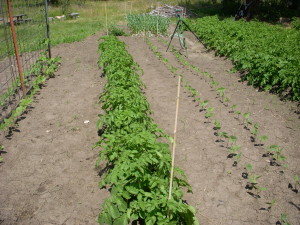Foliar Feeding

Foliar feeding is a method of fertilizing through a plant’s leaves. According to Amigo Cantisano, widely regarded as one of California’s most important proponents of organic farming, foliar feeding will give you more vegetables with higher nutrition and better flavor. Also it will increase resistance to insects and diseases and provide more tolerance to stressors like heat and cold.
The stomata of a plant are the openings on a plant’s leaves and stems that are similar to pores on our bodies. Through the stomata, plants absorb nutrients. These can come from the air, rain, sprinklers, or a foliar fertilizer. With foliar applications, nutrients are absorbed rapidly, usually within 6 to 24 hours.
Foliar feeding should not replace nutrients from soil, it should enhance them. Foliar sprays also can act as catalysts, increasing the nutrient uptake by plants.
Foliar feeding can be done during early growth of the plant, during or after blooming, when is plant is under stress, or just prior to plant maturity to increase brix. Information on increasing brix can be found here. Foliar feeding can be done as often as every three or four days, but even applying once will be advantageous. It is advisable to test spray a plant to check for its response before doing a widespread application.
Foliar feeding can be done at the beginning of an insect attack. Plants with a higher Brix are less susceptible to pests like aphids, whiteflies, leaf miners, thrip, and others.
Foliar feeding should be applied with a sprayer that can produce a mist for best results. The smaller the droplet size, the better the nutrients will absorb. Spray all surfaces of the leaves and stems.
You can use a surfactant, such as coconut oil or a mild soap (1/4 tsp. per gallon of spray), to ensure better coverage of the leaves. Otherwise the spray may bead up on the foliage and you won’t get as much benefit.
The stomata open and close in response to daylight and temperature. The best time to foliar feed is when the stomata are wide open, which is in the early morning or evening. Nutrients absorb best between 65 and 85 degrees Fahrenheit. There should be little or no wind. Avoid watering for the following 24 to 48 hours.
For foliar feeding, you can make your own liquid fertilizer by brewing up compost or soaking manure in water.
Or you can use a liquid seaweed fertilizer. I use Maxicrop. The soluble powder is an economical way to apply seaweed as a foliar fertilizer.
I also use this sprayer for foliar feeding. It is inexpensive, works great, and has received great reviews.

